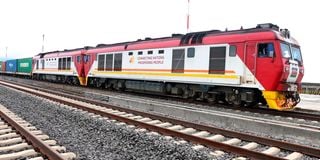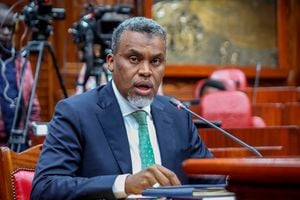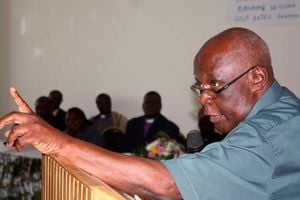
An SGR train at the Naivasha Inland Container Depot on January 17, 2022.
The year 2025 is significant for China-Africa diplomacy and for Sino-Kenya relations. It is a silver jubilee for the Forum on China-Africa Cooperation (FOCAC), founded 25 years ago as the premier platform for policy dialogue and execution.
On January 5-11, 2025, China’s Foreign Minister Wang Yi made the 140th trip by the top Chinese leadership to Africa since 2007. Wang’s trip to Africa (Chad, Namibia, Democratic Republic of Congo and Nigeria) was in line with a 35-year-old tradition of Chinese leaders making the first overseas trip of the new year – or the last overseas trip of the lunar year — underscoring Beijing’s longstanding diplomatic ties with the continent.
The visit sheds light on Africa’s three key aspirations in its relations with China in 2025, anchored on the Beijing Plan of Action (2025-2027): infrastructure for energy and transport; industrialization and trade.
Kenya’s Standard Gauge Railway is a key outcome of FOCAC's stewardship of Sino-Africa relations over the last 25 years. Through FOCAC, the Belt and Road Initiative (BRI) and more recently the Global Development Initiative (GDI), China is providing global public good to Africa and other developing countries. It is in this context that Beijing supported Kenya to build the 600-kilometre railway consisting of a 480-kilometre Mombasa-Nairobi (Madaraka Express) and 120-kilometer Nairobi—Naivasha extension. When completed, the planned 1,300-kilometer SGR railway will reach Malaba on Uganda border. Along this railway, a new Economic Belt has emerged as a new frontier of rapid modernization.
The new SGR Economic Belt is a bridge to economic prosperity, spurring growth and modernization. The railroad is creating Jobs. At the construction stage in the 2019-2023 period, the Mombasa-Nairobi and Nairobi-Naivasha lines created over 70,000 local jobs.
A total of 2,708 Kenyan staff were also employed. Over 2,285 staff from diverse professional backgrounds work at the 33 stations along the railway and in the passenger and cargo rolling stock. The construction company sub-contracted 157 local companies in the project, with more than 1,000 local companies enlisted in the building of the railway at different levels.
Stimulated industrialisation
The SGR Economic Belt is generating revenue for the country: The railway has raised the country’s Gross Domestic Product (GDP) by 1.5 per cent. It is projected that the railway project will contribute 2 per cent to 3 per cent of Kenya’s GDP by 2030.
As an iconic project, the railway has attracted many foreign tourists. Mount Kilimanjaro is visible to passengers from their seats in the Mombasa-Nairobi train. The railway has also stimulated industrialisation, manufacturing, and value-addition and facilitated skills transfer and capacity development.
The Mombasa-Nairobi-Naivasha line has provided a low-cost, comfortable, fast and safe and reliable modern way of transporting people, goods and services. The volume of cargo handled by the Mombasa-Nairobi line has grown steadily from 2.9 million tons in 2018 to approximately 6.8 million tons in 2023.
The SGR is projected to ferry 22 million tons a year, amounting to 40 per cent of Mombasa port cargo by 2035. As a result, it has reduced congestion and traffic snarl-ups on roads. As of December 31, 2024, the SGR had ran 2,815 days of safe passenger and freight services without any major accident of the train wagons.
The SGR has carried 7,000-10,000 people daily, equivalent of 145 commuter buses. In the 2017-2022 period, the passenger trains have transported more than 8 million people. It takes 5 hours for express train and 6 for the Intercounty train from Nairobi to Mombasa compared to 8 to 12 hours before.
The railway has increased demand for last-mile connectivity, creating demand for services in other modes of transport such as buses, taxis and motorcycles thus generating new jobs and boosting incomes.
The SGR is rapidly transforming Kenya into a regional communications hub in a railway network connecting over ten countries from the Indian to the Atlantic Oceans: Kenya, Tanzania, Uganda, Rwanda, Burundi, South Sudan, Democratic Republic of the Congo, Congo, Ethiopia, and Djibouti.
The SGR has spurred a new wave of rapid urbanization. It has breathed new life to some 33 hitherto backwater towns now serving as SGR termini. Impressively, the designs of railway stations in the SGR Economic Belt capture the whole gamut of local cultural milieus of diverse Kenyan communities, aesthetic values of the peoples and the tapestry of the landscapes along the railway line.
Strengthening regional bonds
The SGR Economic Belt is connecting peoples and cultures, enhancing access to new ideas and cultural experiences and reducing isolation in remote areas and strengthening regional bonds. It has also made travel more accessible to low-income social and economic classes. Every February, Kenyan and Chinese rail workers celebrate the Spring Festival, or Chinese Lunar New Year, providing a platform of cross-cultural understanding and for inter-civilisational dialogue.
Mo Yan, the Chinese Nobel Prize Winner in Literature travelled on SGR from Mombasa to Nairobi on July 28, 2023. The Africa Policy Institute (API), pioneered in “Railway Conferencing”, holding its annual Seminar on Outlook on Peace and Development in the Horn of Africa in 2023. During the COVID era, the SGR facilitated the transportation of critical medical supplies and mobility of patients.
Finally, the SGR has provided a model of a climate-smart railway. The SGR has offered a climate-smart and efficient form of transporting passengers, goods and services. Tapping into cutting-edge technology, the SGR project struck the necessary balance and harmony between development and nature, avoiding humans-animal conflict, allowing free movement of animals while reducing vibration, noise and discharge sewage properly in the Nairobi National Park and the Tsavo National Park.
At Tsavo, a high-elevated bridge was built, with a minimum clearance of 6 meters, and a maximum of 42.5 meters, allowing even the tallest giraffe—like the world’s tallest giraffe named George which stood at 5.8 meters (19 ft)—to pass through freely at the lowest spot. The Great Land-Bridge that stands at 6.5 meters above the ground was erected over the Nairobi National Park.
FOCA’s agenda to accelerate agricultural modernisation and support Africa’s industrialization, energy and trade over the 2025-2027 period will greatly boost the creation of a modern 21st-century Kenya along the SGR Economic Belt.
Professor Peter Kagwanja is the Chief Executive at the Africa Policy Institute and the Co-Author of Railway to Prosperity: Kenya's Standard Gauge Railway Economic Belt (Nairobi: Tafiti House Publishers, 2025).









